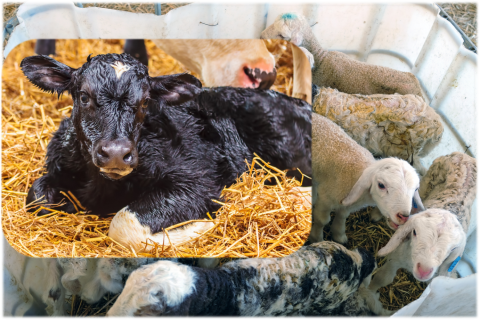25 January 2023
Dr David Cutress: IBERS, Aberystwyth University.
- Following birth, livestock are highly susceptible to diseases and mortality rates are high
- Management of the newborn’s navel region is important to prevent infections from tracking through to the animal’s internal organs and causing greater damage
- Dressings applied to this region are important to desiccate the umbilical stump and boost the rate of healing, whilst also protecting the animal from bacteria
- Equally important is general birth environment hygiene, biosecurity and colostrum management for the transfer of active immunity antibodies
Following birth, newborn livestock have underdeveloped immunological defences and as such are far more susceptible to disease. This is one of the reasons that this period in the production cycle is often considered a time of risk and an area of interest for improving productivity and welfare on farms. Currently, in the UK, averages of between 3 – 6% of all calves born, die in the first 3 months of life, whilst between 5 – 7% of all lambs born die early in life. Whilst previous KE Hub articles have discussed broad control areas for improving neonatal survival including biosecurity, technologies and good nutritional management (particularly surrounding initial colostrum supply), an aspect which has had little discussion is the route of infection via the umbilical cord. The umbilical cord contains two umbilical arteries, the umbilical vein and the urachus, which can all act as routes for infectious invasion of the newborn due to acting as essentially open wounds. Infection of the umbilical stalk and surrounding regions (omphalitis) will lead to visible swelling, pain in the region, and often discharge. Other diseases associated with this infection include ill-thrift, though documented cases are more common in calves than lambs, along with infections of internal organs, including the liver and bladder, via the direct routes highlighted in the diagram below.
The concern
The cause for concern for livestock producers is that these umbilical infections can cause economic and welfare losses, due to treatment costs (which can include surgery), reduced growth weights, long-term disease issues and increased mortality rates. Some studies show up to 14% of dairy calves suffer from these infections whilst figures are more difficult to obtain for lambs. Despite this, joint-ill (associated with umbilical infection) is thought to impact between 1 – 2% of lambs in a flock on average (with severe cases on farm impacting up to 50% in certain cases), suggesting it is of concern to the industry.
Under standard management practices, it is common to treat the navel region of newborn livestock as soon as possible to ensure the least likelihood of infectious spread. This is followed by further treatments until the region is healed and the dried-up umbilicus drops off. As with the spreading of all bacterial infections, a key component which assists a bacteria’s transfer, colonisation and survival is the supply of a moist warm environment. As such, the navel offers a perfect location, if it is not disinfected correctly and dried out where possible. Similarly, this is why animals must be monitored and treated more thoroughly and possibly regularly in poor conditions, such as heavy rain and high moisture, which act to provide better transfer conditions for bacteria and wash away treatments applied to the navel more quickly. Also, male offspring may require increased consideration due to their urination removing treatment from the umbilicus and preventing it from drying out successfully.
Management options
In treating the navel region, the optimal dressing involves a substance that can desiccate (dry up) the area it is applied, whilst also either acting as a barrier to the bacterial establishment or actively killing bacteria or supplying some form of antibacterial property. This property would work best the longer it is active post-application, as it means fewer subsequent treatments are required. Furthermore, with the rising concern of antimicrobial resistances (which include antibiotics), there should be careful consideration of the active antibacterial reagents being used, as overuse could lead to environmental bacteria acquiring further resistance, causing knock-on problems to farm production overall.
Iodine diluted in an alcohol base (to provide active desiccation of the area) usually used at a 7 – 10% concentration is the mainstay treatment of choice in most instances. It is also recommended by most agricultural advice services in the UK including NADIS and AHDB. Whilst the efficacy of iodine tinctures has been demonstrated across multiple studies, it is important to note that a recent study has highlighted that there is more importance to ensuring correct colostrum management, hygiene and other farm-level factors. One key farm-level factor is separating animals into clean, dry and regularly cleaned birthing pens in preparation for birth, as this can have a huge impact on disease spread and such strategies are commonly echoed by farm advice bodies, particularly when the standard farm regime would only supply a single dose of iodine without careful and considered follow-up doses. Furthermore, iodine is associated with a detrimental damaging impact on cells and as such may have some complexity regarding its impact on animal welfare, particularly if less toxic equivalents are available.
Products containing isopropyl alcohol for desiccating activity and acids and surfactants for antimicrobial impacts include sodium hydroxide, sodium bicarbonate (e.g. Vetericyn Super 7 Plus spray/dip) and citric acid and surfactant (e.g. Navel Guard). This dual activity helps to dry up the region to reduce bacterial colonisation whilst the acid and surfactant element further discourages/prevents bacterial growth and infection. In a study in 2010, a citric acid-based product was shown to be more efficient at preventing infection than not dipping navels and it was comparable in its effects to 7% iodine treatments. Products are often available as navel dips and sprays (eg. Vetericyn super 7), but most studies suggest that dipping tends to outperform sprays and it is for this reason that iodine (the current mainstay choice) is utilised as a dip.
Chelated copper sulphate, zinc chloride and alcohol in butane have demonstrated function as well as if not better than iodine with lower application volumes and reduced costs. Its activity on navels in the form of ‘Repiderma spray’ has been presented in a whitepaper examining 200 dairy calves, but no peer-reviewed comparisons could be found relating to its application on navels only to digital dermatitis, sores and general wound healing.
4% chlorhexidine or a 50/50 mix of 4% chlorhexidine and alcohol (2% final volume) are also noted for an equal activity to iodine tinctures. Chlorhexidine has a longer duration of activity against bacterial interaction than iodine and shows activities against both gram-positive and gram-negative varieties. Compared to iodine it has also been demonstrated to have fewer toxicity issues and is less likely to irritate the surrounding skin to the same extent. Despite this, it is largely sold as a skin and cut disinfectant and for general cleaning disinfection in the equine industry, though it is also a component of some disinfectant teat dips on the market.
Overall, where studies are available for comparison between products, these are highly limited and exclusively for the evaluation of cattle. Treatment for the comparison of a citric acid-based product, 7% iodine and chlorhexidine gluconate found that each performed equally well. Interestingly in this study, chlorhexidine was used at 2% rather than 4%, further suggesting that lower dosages may still be functional, which could reduce costs further for farmers. Whilst another short-term study, looking solely at the impact of antiseptics in the 24 hours following birth, again showed that chlorhexidine was as effective as 7% iodine (though this time at 4%) and further noted roles for 10% trisodium citrate and 0.1% chlorine.
An important consideration regardless of the disinfection measure used is the hygiene of the application itself as a route for further infection spread. For solutions like iodine it has been shown that the best application method for success is dipping rather than spraying, the issue with this is that dipping may contaminate the iodine stock used which could then increase infection risks with all following dips. For this reason, it is suggested that each animal is dipped in a separate stock of iodine, with any remaining iodine disposed of or utilised in less sensitive processes. Otherwise, reusable dipping cups/containers must be cleaned with bleach and rinsed with clean water between each use. Similarly, as with other treatments, farm hygiene is important, with the regular cleaning of equipment, clothing, and use of PPE such as disposable gloves and aprons, all likely to assist in the management of disease-free systems.
|
Product example |
Average cost (L) |
Notes |
|
Iodine 10% |
£44.01 |
|
|
Iodine 7% |
£22.10 |
|
|
Chlorhexidine (gluconate) 4% |
£16.63 |
Larger volumes were far cheaper |
|
Chlorhexidine (gluconate) 2% |
£23.67 |
If self-diluted in 100% ethanol may work out slightly cheaper |
|
Chlorhexidine (gluconate) 0.5% |
£13.48 |
Literature citing this concentration wasn’t found for navel application but veterinary advice pages and purchase options suggest it is used |
|
Repiderma spray |
£40.31 |
The spray requires a third less volume per dose according to the company which would impact the cost per animal |
|
Vetericyn super 7 plus spray |
£47.24 |
Spray likely requires less volume per dose so may work out cheaper per animal |
|
Vetericyn super 7 plus dip |
£15.92 |
|
|
Povidone-Iodine 3% |
£7.31 |
Generally sold as 10% so requires diluting in water. It is suggested to be effective down to 1% by some veterinary sites so would be cheaper but efficacy is questionable for this product due to lack of desiccation |
|
Navel guard |
£7.96 |
Unavailable in the UK |
|
Chlorine 0.1% |
N/A for this application |
Utilised in drinking water disinfection but also a single calf study found it equivalent to iodine. It is also present as chlorine dioxide in many teat disinfectants on the market |
|
Trisodium citrate 10% |
£6 |
Dilute 100g of trisodium citrate in 1000 ml water. This product was only found in one paper of 24 hours post birth of calves with equal activity to iodine |
Note – the prices above are based on online searches in January 2023 from both agricultural providers and alternative sources and where applicable include the postage costs. Bulk discounts and other farm stock provider discounts were not considered
Summary
In livestock, following birth, the umbilical cord acts as a potential open route of infection into the animal. As such, a percentage of all neonatal deaths across livestock species relate to infections directly in this area, or secondary infections tracking back into internal organs (particularly the liver and bladder). To minimise this infection risk and reduce welfare implications, the application of dressings is common. Whilst iodine has been the mainstay treatment choice, it is not the only option, with equivalent choices having reduced impacts on cell and tissue damage and toxicity. Whilst this management option is important, it appears to be equally, if not more vital, for farmers to ensure good hygiene at birthing (regardless of the livestock animal in question), to ensure good colostrum management and to ensure strong biosecurity measures are in place to avoid bacterial transfer throughout the farm environment.
If you would like a PDF version of the article, please contact
heledd.george@menterabusnes.co.uk



